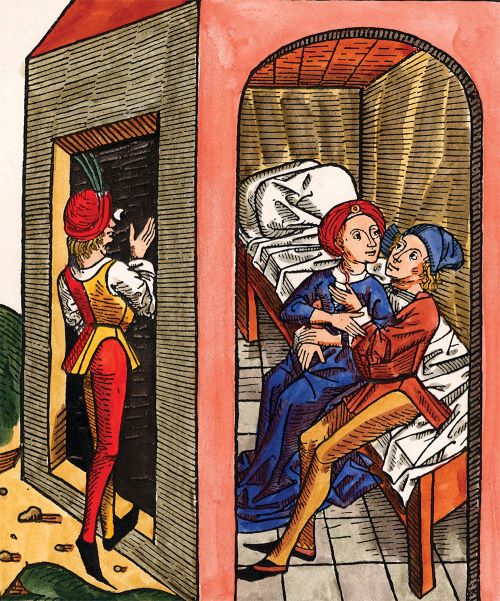
Prostitutes and their labor on the surface appear to oppose the social, cultural, and gender norms of Medieval London, however, in London and the rest of Europe, prostitution was a tolerated and heavily regulated profession. The expectation of chaste, modest women saving themselves for marriage was reinforced by the Church, local officials, and local communities. Prostitutes, bawds, and brothel keepers defied social and gender customs, and at times the law. Legal documents from the Medieval period provide insight into the regulation of prostitution, their experiences, and labor variation.
Similar to many European urban centers, London officials sought to regulate and limit prostitution. Several attempts to ban prostitution from London completely were made in the late 13th century to the early 14th century, but they never stuck. The Liber Albus, a collection of laws and customs from London around the late 14th century, banned prostitutes from the city. “No woman of lewd life, bawd, courtesan, or common scold, be resident in the [city].” By the end of the 14th century city officials settled on limiting prostitutes to one section of the city, Cock Lane, but many prostitutes operated throughout the city and country illicitly. Laws also regulated the clothing of prostitutes, they had to wear a striped hood and could not dress in excess to not attract the attention of female nobility. Despite intense regulation, London courts did not have a definition of prostitution or whoredom. Women could be fined and accused of prostitution based on rumors and gossip. Promiscuous women and alleged female adulterers could also be accused and fined for prostitution even if no money was exchanged. Being accused of illicit prostitution, whether true or not, could significantly damage a woman’s image. It also had the potential to make it extremely difficult for a woman to marry out of the sex trade if she was accused because it would impact her reputation and suitor options. According to the Liber Albus, if a woman was found guilty of prostitution or being a bawd, she would be brought to the thewe before the mayor and aldermen and have her head shaved. If found guilty three times: “Let her be taken to one of the Gates of [London],” and banished forever.
Prostitution, like other fields of labor, was varied. Brothels existed, but it was much easier and more profitable for prostitutes to frequent taverns, homes, or the streets. Brothels were regulated and had stricter rules than if a woman walked the streets. Many prostitutes likely had a bawd or pimp that procured a customer for them and took a portion of their earnings. Indicative of London’s lack of legally defining prostitutes, based on records it is hard to discern the hierarchy of the trade. Cortesans or high-profile prostitutes likely existed, but weren’t as common as those found in mainland Europe. Escorts or a role similar likely existed, with a bawd or pimp as the mediator. “Streetwalkers” was a common role for prostitutes, simply walking around London looking for customers. Even women who were not prostitutes could be accosted by random men assuming they were sex workers.
While Medieval prostitution was regulated, it was not an easy nor desired career for women. It had the potential to provide quick and easy economic gains but at great risk to the woman’s reputation and value as a future wife and member of society. Even women who were not prostitutes but transgressed social norms could be accused and have their reputations damaged in a similar manner. Some women could be successful prostitutes, like Isabella Wakefield of London who was respected in the community despite being a prostitute and later a brothel keeper. The experiences of London prostitutes varied, but the one constant was the social and legal stigma many women faced while trying to earn a livin.






